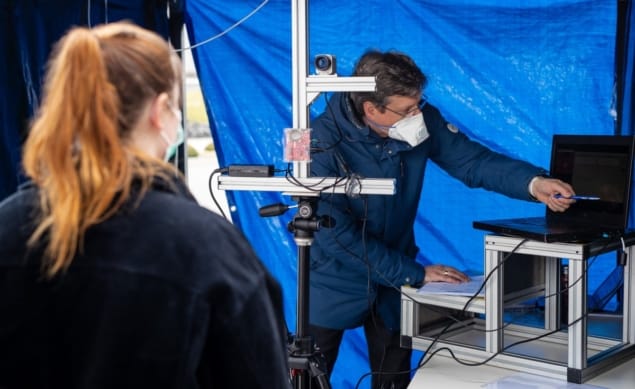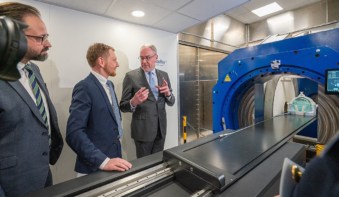
A system that checks from a safe distance whether someone is displaying symptoms of COVID-19 has been developed by Urs Schneider and colleagues at the Fraunhofer Institute for Manufacturing Engineering and Automation in Stuttgart, Germany. The team’s “access checker” combines infrared and microwave measurements and is already being tested at a Stuttgart hospital. The researchers believe that their system will become an important tool for ensuring the safety of healthcare workers, patients and hospital visitors.
To slow the spread of COVID-19, it is crucial for hospitals to enforce strict yet efficient entrance controls for staff and visitors. To carry out these tests, however, workers must come into regular contact with potentially infected people, putting both parties at risk. As a result, staff controlling access to hospitals must wear personal protection equipment, which is cumbersome and currently in short supply in some places. To address these issues, Schneider’s team created a device that uses a combination of measurements to detect some symptoms of the disease remotely.
One part of the access checker scans a person’s body temperature by measuring infrared radiation emitted by their skin. This is done to detect fever, which is a symptom of COVID-19. The device also checks for increased heart and breathing rates associated with the disease. This is done using a micro-Doppler radar system that bounces microwaves off the subject to detect body motions associated with breathing and blood flow. A similar technique is used by radar guns to measure the speed of vehicles.
Safe distance
Since the device can be operated remotely using a laptop, it allows healthcare workers to maintain a safe distance of more than 2 m from their subjects. Therefore operators do not have to wear personal protection equipment.

AI checks CT scans for COVID-19
Schneider’s team have built a prototype of their remote access checker, which is currently undergoing its first trial run at the main entrance to the Robert Bosch Hospital in Stuttgart. Tests have already shown that the scans can be carried out just as fast as conventional tests for COVID-19 symptoms.
Several hospitals in the surrounding area have already expressed interest in the system and Schneider’s team have now drawn up ambitious plans to build four more monitors to serve them within just two weeks. Ultimately, the team hopes that their work could provide a critical tool for governments and healthcare workers as they fight to contain the spread of COVID-19. Schneider also believes that the technology has applications beyond COVID-19 scanning and could be used for routine screening in locations such as care homes and airports.



